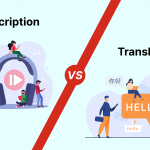
Subtitling refers to converting speech into a text. Typically, subtitles are displayed at the bottom of a screen. The subtitling process includes interpreting what is spoken, transcribing (writing) it, and finally translating the transcribed file to create multilingual video content.
What is the difference between captions and subtitles?
Many times, the terms subtitles and captions are used interchangeably as they both refer to the text displayed in on the screen. However, a captions are the text of the same language used in the video whereas subtitles are the translated text for the global audience.
What are the types of captions?
Open captions: The text that the users cannot turn off is known as open captions. The captions are permanently written on the video or media file. Therefore, it runs automatically without the users having to activate it. Open captions are ideal for educational videos as the viewers can archive the content easily for future reference.
Closed captions: The users can turn on/off the captions at their discretion. For instance, the content streaming on OTT platforms such as Netflix has one or two lines of text running along with the video below the screen. Thus, the users can customize their viewing experience with closed captions.
SDH (subtitling for the deaf and hard of hearing) captions: The SDH captions are best suited for videos created for deaf and hard of hearing users. These captions also describe the emotion or action in a scene for an engaging user experience. For instance, (happy music plays), (sighs), (sound of the door slamming), etc.
What are the advantages of captioning & subtitling?
- It increases audience engagement: Videos with subtitles attract a larger audience. The subtitles help the audience understand the content of the video better. For instance, if a video is made in Japanese, with English subtitles, the video will have better viewership and engagement globally, given the significant number of English-speaking viewers.
- It helps learn a new language: Subtitles help users, especially with ESL (English as second language) learn a new language and enhance their communication skills. It is an interesting yet effective way to understand the nuances of a new language, provided the subtitles are free of grammar and language errors.
- It gives a better user experience to the audience with hearing disabilities: The video subtitles enable users with hearing disabilities to interact with and understand the video better.
- It provides easy access to essential resources: This is one of the major advantages, especially for the students or researchers who want to save vital points, links, or data from the video content. The subtitles help them record essential resources which can be accessed at any time from anywhere.
Why should businesses opt for captioning and subtitling services?

Business man pressing high tech type of modern graph on a virtual background
- It helps in globalization: Videos with subtitles generally reach a wider audience worldwide, enabling businesses to enter the global market easily. The audience will understand the brand’s message regardless of the language barriers.
- Localization: Subtitling means translation of the video’s language into the language of a specific region. For instance, a video in English can be localized for the audience in China by using Chinese subtitles.
- It improves SEO: Subtitles help in enhancing the visibility of the videos. When the subtitles consist of SEO-friendly keywords, the video crawls faster into the search engine. It attains higher visibility and garners more traction from the audience worldwide.
- It enhances brand value: One of the most effective ways for brands to improve their value globally is to opt for subtitling services. It helps the brand connect with its audience across multiple geographies effortlessly.
- It improves social media reach: According to a study, captions or subtitles boost video shares by 15% and CTA by 26%. Subtitles make videos engaging, and they become highly viewed and interacted with on social media.
The top 3 best practices for video captioning and subtitling
Accurate timing: The subtitle must be in tandem with the visuals played on the screen because each second counts. Therefore, the viewer must have sufficient time to read and understand the subtitle. If the subtitles lag or run faster than the visuals, it disrupts the viewing experience.
Compliance with regulatory guidelines: The subtitling and captioning must be done according to the FCC (Federals Communications Commissions) regulations. In additions, the subtitles and captions must ideally meet the quality standards as per the Netflix and The Described and Captioned Media Program (DCMP).
Consistency: The subtitles presented in the video must have a consistent font, style, font size, color, etc., for better clarity and coherence.
Subtitling is a time-intensive process, and one must consider multiple aspects to ensure the subtitling is effective. Starburst game have enough bonus coins to bet large in a spin and win more back. Therefore, it is always best to choose professional subtitling services.
What should one look for while opting for professional subtitling services?
- Quality: The subtitling services provider must be quality-conscious and ensure the subtitles are highly accurate, precise, and boost viewership significantly.
- Timely delivery: The subtitling services must have a quick turnaround time to prioritize the customers’ deadlines.
- Data security: The provider of subtitling services must secure the customers’ confidential data.
Subtitling services are highly beneficial for those looking to boost the engagement rate with their video content. Therefore, it is imperative to choose a subtitling services provider carefully.







Share your thoughts